Big Changes at The Brewery
Once-abandoned Pabst brewery has become active neighborhood
It’s been twenty years since Pabst Brewing called it quits at their Downtown Milwaukee brewery. Ten years ago the complex was still a collection of empty buildings, with papers left strewn about on desks, indicating just how abruptly the brewery closed its doors.
Things are a whole lot different today. Under the guidance of Zilber Ltd., the abandoned brewery has become an active neighborhood with a mix of restored and newly constructed buildings. The broken glass and chain-link fences have been replaced by bioswales and immaculately restored buildings.
From Church to Brewery
The project hit a milestone a few weeks ago, when Zilber Vice President emeritus Mike Mervis made what he said was a final appearance before the city’s Historic Preservation Committee to secure design approval for the building’s last-to-be-redeveloped historic building. That building, originally built as the First German Methodist Church, was last used as a training center by Pabst. Ironically, the brewing giant, under new ownership, is reopening the facility as a micro-brewery for some of their lesser-known recipes.
Construction work is underway with a fall opening planned. Blue Ribbon Management and Zilber are partnering to redevelop the building. For more, see my 2015 article from the project’s announcement.
Apartment Project Underway
Another long-anticipated project is underway at The Brewery. Whitestone Realty Capital will convert the former malt house and malt elevator buildings into 118 market-rate apartments. The project, which was originally approved in 2014, has been anticipated for years, with the development team originally proposing it as senior housing.
The buildings date back as far back as 1882 and contain a combined 158,500 square-feet of space. They’re instantly recognizable to many as Building 24 (the malt house) serves as the southern anchor of the gigantic Pabst sign that straddles W. Juneau Ave. Building 25, the malt elevator, is a narrow building that stands between the former church and the significantly larger malt house. Work is underway on both to restore the brick-covered windows and clear out the interior.
For more on this project, see my 2014 article on the project’s approval.
New Park Planned as Another Project Nears Completion
A student housing project is nearly complete on the southern end of The Brewery. The former bottling house (Building 29), built in 1889, is being converted to student apartments known as Eleven25 at Pabst. At 237,000 square-feet it’s no small project, and will include space for up to 400 students when complete. It’s being developed by a partnership between Blue Ribbon Management and Zilber. The project is financed in part by the EB-5 program, which allows foreign nationals to obtain green cards in exchange for job-creating investments in targeted areas. Architecture firm HGA is leading the project’s design under the watchful eye of partner Jim Shields.
When complete the project will include five restaurants and other amenities intended to serve the neighborhood. The building is expected to open in August and is currently accepting applications.
Completing the block, a new park is planned for the space immediately east of the building at the southeast corner of W. Juneau Ave. and N. 10th St. Dubbed Preservation Park, the park will honor the brewery’s history with historical artifacts embedded in 12-inch deep boxes embedded in the ground. Construction is expected to begin this summer.
Photos
Other Projects at The Brewery
A substantial number of projects have been completed at The Brewery.
- The Pabst Professional Center office building is complete and has attracted a number of tenants, including recently profiled SafeNet Consulting and a satellite office for Pabst Brewing.
- Streetscaping work has been completed that gives W. Juneau Ave. a layout very similar to Broadway in the Historic Third Ward.
- The Frederick Lofts (new construction), Brewery Point Apartments (new construction) and Blue Ribbon Lofts (adaptive reuse) apartment buildings have been completed.
- Cardinal Stritch University (adaptive reuse) and the UW-Milwaukee Zilber School of Public Health (adaptive reuse and new construction) both have a significant presence in the neighborhood. Cardinal Stritch, which occupies the Research Lab building, is looking to sublease their space as part of changes at the university.
- Best Place at the Historic Pabst Brewery, a bar and hall, has opened a second hall known as the Great Hall.
- The Brewhouse Inn and Suites hotel and attached Jackson’s Blue Ribbon Pub seem to do a brisk business.
- The LEED Gold certified parking garage opened in 2009 with 908 stalls.
- The former boiler house (Building 10) is now the Boiler House Office Building and has been open since 2008.
- Zilber Park is open, honoring the legacy of Joseph and Vera Zilber.
- Milwaukee Brewing Company is working to open a brewery in the former Shipping Center (Building 42), originally built in 1970.
Friday Photos
-
Michigan Street Commons Nears Completion
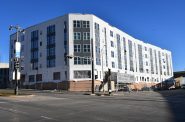 Mar 15th, 2024 by Jeramey Jannene
Mar 15th, 2024 by Jeramey Jannene
-
See The View From The Couture’s Upper Levels
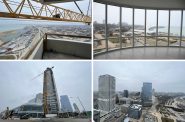 Mar 8th, 2024 by Jeramey Jannene
Mar 8th, 2024 by Jeramey Jannene
-
Demolition Work Begins For Massive Affordable Housing Development
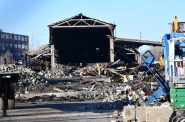 Feb 16th, 2024 by Jeramey Jannene
Feb 16th, 2024 by Jeramey Jannene


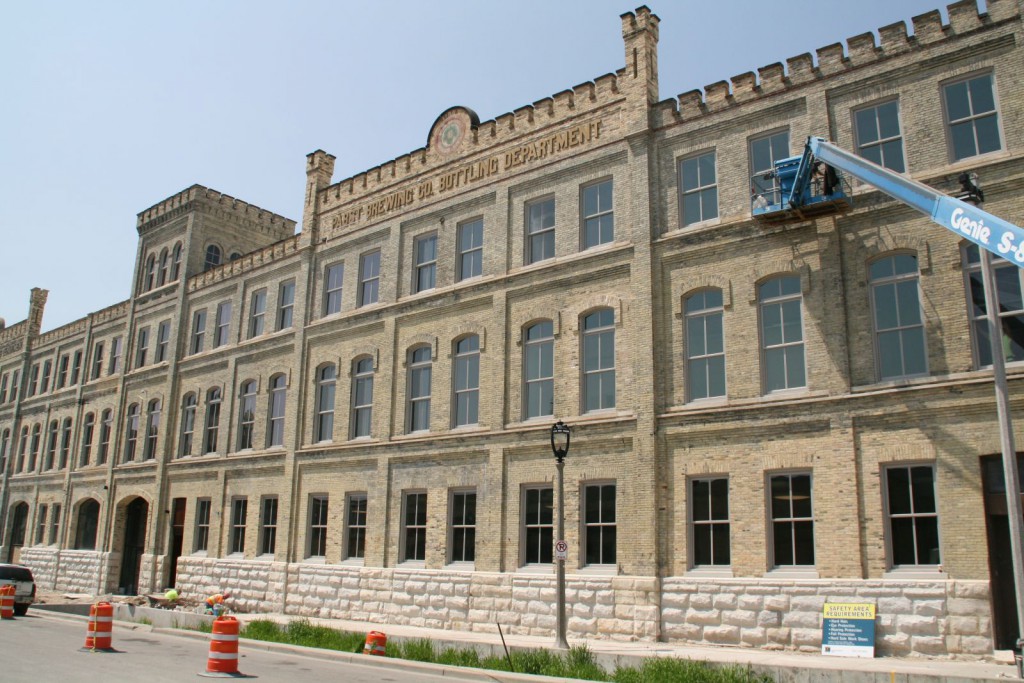
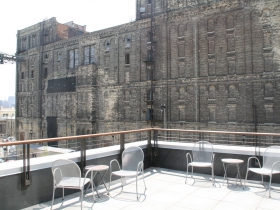
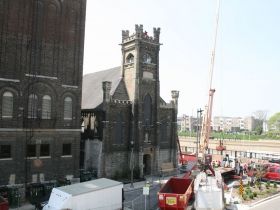
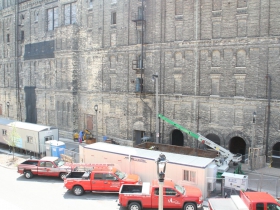
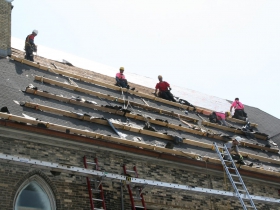
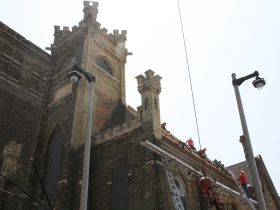
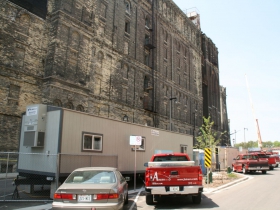
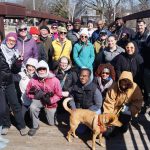














This area has filled in rapidly in the last few years. What has been the biggest accelerator, the economy or the political atmosphere?
Jeffrey, multiple developers have been involved with various projects. The pace of development seems to be partially based on incremental drivers. For example, Jackson’s, Brewhouse Suites and Best Place have been big successes, thus bringing more activity and interest. Historic tax credits have also served as incentives for repurposing buildings. Several projects serve higher education (UWM, Cardinal Stritch and student housing for multiple institutions). The food court will serve student and other populations, so it’s all related.
Jeramey: That’s good news about the park. Do you know if it will be considered a “privately owned, publicly accessible space”? That requires having a public easement. Or will it be a community space for the use of residents, or a traditional publicly owned park? Each has value but functions differently.
@Virginia – The park will be managed by the neighborhood improvement district that also manages Zilber Park. I don’t know off the top of my head if the NID also will own the park. They are effectively public parks to the end user, although I would suspect they vary in a few ways from a county-owned park.
@Jeff – I think there are a number of factors. First, Joseph Zilber had the bold vision to attempt the project and buy the entire complex (with the exception of Best Place). Second, the city wisely rejected the entertainment district TIF plans, and supported a TIF for Zilber’s plans. Zilber contributed personal funds to seed at least one of the projects (the UWM Zilber School of Public Health). They also built a large, central parking garage shared by all of the tenants.
Second, the tax credits have certainly helped, but things were moving incrementally before that. WHEDA low-income housing tax credits helped. EB-5 financing is a huge driver. If there is a financing method out there, Zilber Ltd and partners have found it and utilized it.
The project is impressive not only for its diversity of uses, emphasis on preservation and pace at which it happened (during a recession), but in addition for where it happened. Sure the brewery is “downtown,” but it’s less than two blocks from public housing, a jail, homeless shelter , and welfare center. Not exactly a developer’s dream. Yet, they’ve made it work and hopefully in due time will drive investment in the adjacent neighborhoods.
The success makes it that much more head scratching why Milwaukee County was unable to do much of anything with the western Park East land before ultimately selling to the Bucks. Kudos to Zilber.
It took a Master Developer like Zilber to get the ball rolling and a huge leadership commitment that we will do this. The City of Milwaukee did their part with tax incremental financing. Dan McCathy was hired as the lead project manager, and had previously held a similar position with Milwaukee. Dan had a lot of history and knowledge about the properties and potential directions for development.
The entire project sought LEED Neighborhood, and attained Platinum status. Many of the individual projects attained levels of LEED status. Again, this did not happen by accident.
During my career at We Energies till 2010, we ran a New Construction Program to support projects that attained higher levels of efficiency and a few projects took advantage. Support funding was also provided for the parking structure LED lighting along with a study of the benefits. http://www.seventhwave.org/publications/adjusting-lighting-levels-commercial-buildings-energy-savings-institutional-tuning
http://www.thebrewerymke.com/
The Third Ward and Menomonee Valley are other successful neighborhood wide projects that when started, were laughed off by many as impossible. We have now seen the impossible take place at least three times in Milwaukee over a short time span of about 10-15 years for each major development to come to fruition. And all still have projects ongoing.
This does not happen by accident and takes positive cooperation and effort by public, private interests, universities and non profit organizations.
Having worked in the complex for two years, I’d like to say that it will be a godsend when retail fills in. It’s like a prison on a hill right now.
Some challenges for this entire location exist. It is blocked off by freeway to the west and roadway to the north. MATC and government buildings to the south, and lack of connecting development to the east. So it still remains kind of an island. Traffic flow, bus connections, and development to the east could improve this fragmented connection.
Third Ward and Menomonee Valley were similar islands and connections were improved. All are still a work in progress.
Let’s not forget that the original “Pabst City” plan called for demolition of many of the old buildings, including the church. Advocacy by the historic preservation community helped kill that awful plan. This project is a model of how old, seemingly too-far-gone buildings can be brought back to life, creating distinctive places in the process.
My mother lives in a VERY ACTIVE senior housing project on 9th. I think the elders in the neighborhood lend to the character it is developing. They are frequently contacting representatives to improve bus stops, add lighting etc. Brewery Point Apartments is also LGBT senior friendly.
The Brewery 1
When are you guys going back
to update when the old German
Church/ Pabst Microbrewery.
Thanks, Thomas burns
@Thomas – We’ll be back real soon. It’s been near the top of the list for quite awhile. Not this week, but hopefully next.